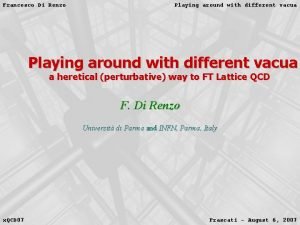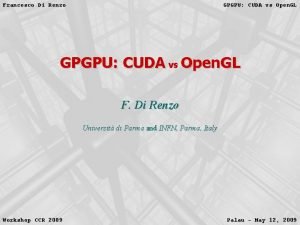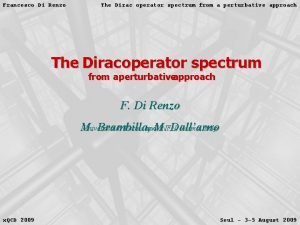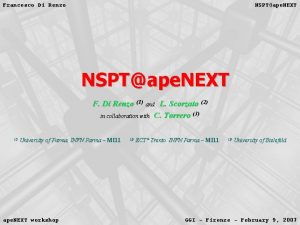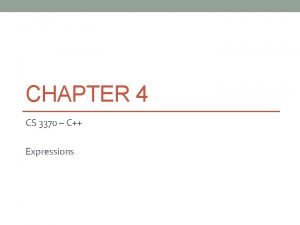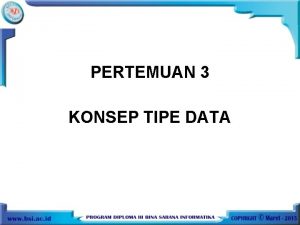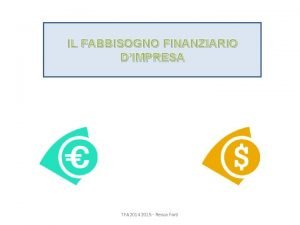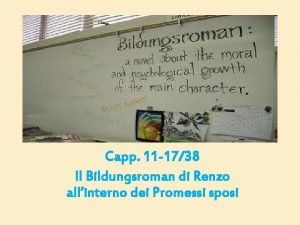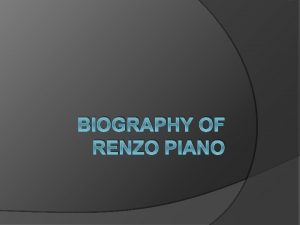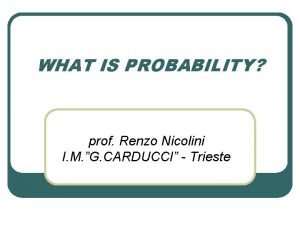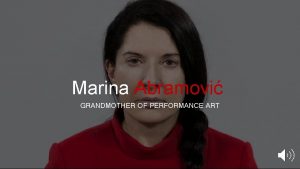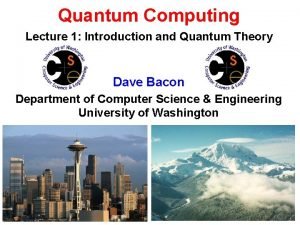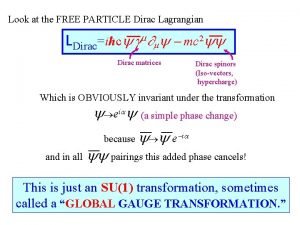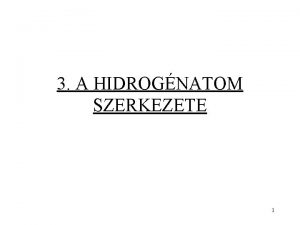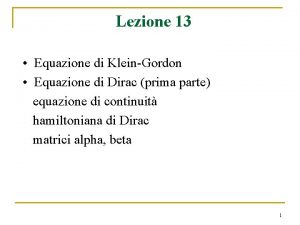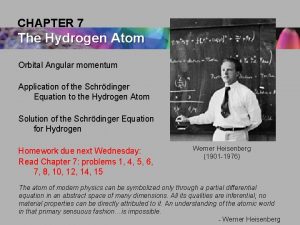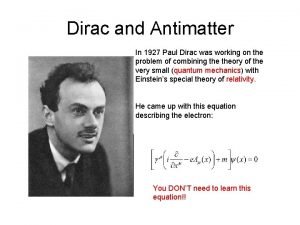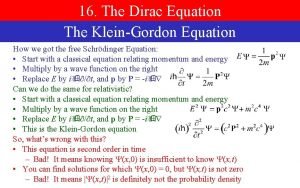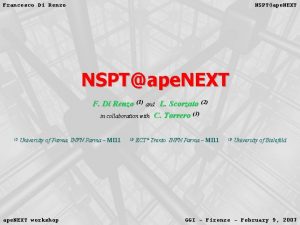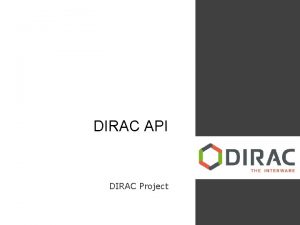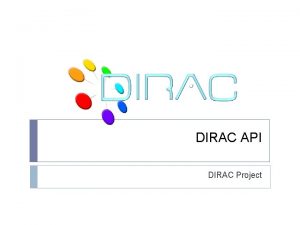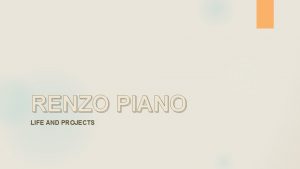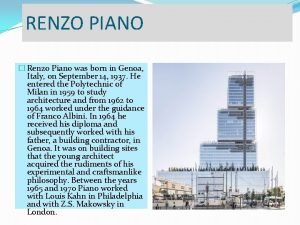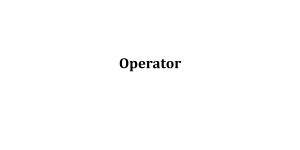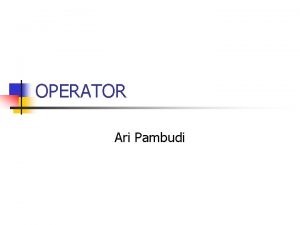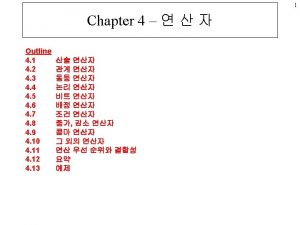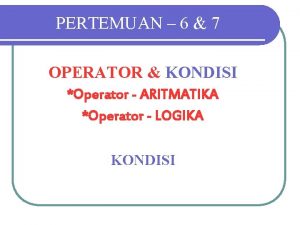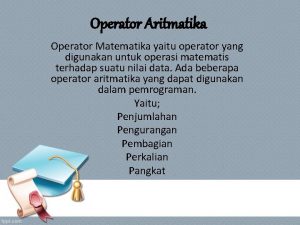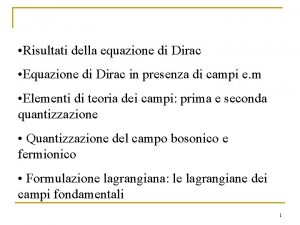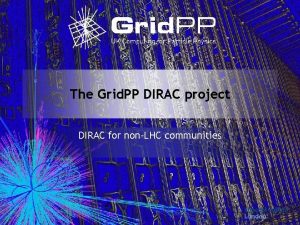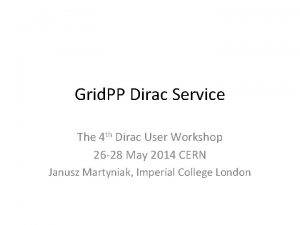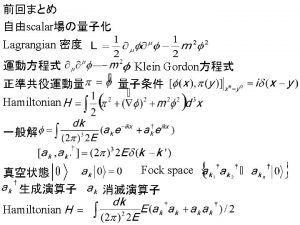Francesco Di Renzo The Dirac operator spectrum from

























- Slides: 25

Francesco Di Renzo The Dirac operator spectrum from a perturbative approach The Dirac operator spectrum from a perturbativeapproach F. Di Renzo Università di Parma and INFN, Parma, Italy M. Brambilla , M. Dall’arno x. QCD 2009 Seul - 3 -5 August 2009

Francesco Di Renzo The Dirac operator spectrum from a perturbative approach My own expertise has been for quite a long time in a (non diagrammatic) way of doing Lattice Perturbation Theory. I have to warn you that this is still another application of NSPT! Disclaimer : this is work in progress … In what follows I collect mainly ideas and very preliminary results: this is really work in progress. Still, I think there’s already some flavour of what we aim at. Let’s have a very first glance x. QCD 2009 Seul - 3 -5 August 2009

Francesco Di Renzo The Dirac operator spectrum from a perturbative approach Outline Ø Preludio: the spectrum of the Dirac operator as a probe for chiral (and deconfinement ? !) transition. Ø Polyakov loop, Z(3), different boundary conditions and all that. . . Ø A skecth of the technique by which computations were made (NSPT): § from Stochastic Quantization to Stochastic Perturbation Theory § from SPT to Numerical SPT § The case of Lattice Gauge Theories and different vacua. Ø The computation of the spectrum: a degenerate eigenvalue problem in Perturbation Theory Ø Very preliminary results: where do the Dirac eigenvalues accumulating near zero come from? Ø Our spectra are highly degenerate: do we need a regulator? x. QCDØ 2009 Outlook Seul - 3 -5 August 2009

Francesco Di Renzo The Dirac operator spectrum from a perturbative approach w t. W e h The Dirac spectrum: why a e ta transition associated to chiral symmetry breaking has a natural order parameter and this is connected to the The Dirac operator spectrum (Banks and Casher, 1980). This made the Dirac eigenvalue density (which is not a rr natural observable in Field Theory) a natural quantity to be interested in. d e e o l e l a se t d is o p t n o n w tl e a o n o a e k o r u fe so rl co h a o in k rx. QCD 2009 Seul - 3 -5 August 2009 i

Francesco Di Renzo WT ih te h s tm ha il sl re ei sg pe en cv ta l Pu ee rs t uw re b x. QCD 2009 The Dirac operator spectrum from a perturbative approach Seul - 3 -5 August 2009

WFrancesco Di Renzo e w cs ati al n rl nt c e o v m u e pr ut htj o e ul ert h n s e s y s h p w o ei p ct e ht rt x. QCD 2009 The Dirac operator spectrum from a perturbative approach Seul - 3 -5 August 2009

Francesco Di Renzo TD ae ka el i cn ag r ew i ot fh The Dirac operator spectrum from a perturbative approach s. W pi e It l turns out that these spectral sums can be mapped to composite inrenormalization Twisted Mass As Then a consider matter ofthe fact spectral sums observables defined asare (it isnot sufficient that natural to understand as operators objects their (observables ? ) in c QCD s , in terms of which theyinvert have to a get natural renormalization prescription (renormalize all the Quantum properties Field because Theory one. can mode number) t masses o which are around with ZP…) Define the average number of eigenvalues of Dm†Dm within a given threshold rn a lf e or bm si eo x. QCD 2009 Seul - 3 -5 August 2009

Francesco Di Renzo T O h u re The Dirac operator spectrum from a perturbative approach Polyakovloop, Z(3) and all that… Are spontaneous chiral symmetry breaking and confinement in the end related? ir e d l e a : t i co n o m b p e u tw e e tn h A In his years more ago recent Gattringer words, put “theforward response a relation of Dirac between spectra Polyakov to different loop and temporal Dirac boundary spectrum c few e in conditions containsofinformation different Z(3) about vacua. confinement”. h the background i D ir ra lx. QCD 2009 a Seul - 3 -5 August 2009

Francesco Di Renzo The Dirac operator spectrum from a perturbative approach From Stochastic Quantization to NSPT comes almost for free from the framework of Stochastic Quantization (Parisi and Wu, 1980). From the latter originally both a non-perturbative alternative to standard Monte Carlo and a new version of Perturbation Theory were developed. NSPT in a sense interpolates between the two. Stochastic Quantization and Stochastic Perturbation Theory Given a field theory, Stochastic Quantization basically amounts to giving to the field an extra degree of freedom, to be thought of as a stochastic time in which an evolution takes place according to the Langevin equation In the previous formula, h is a gaussian noise, from which the stochastic nature of the equation originates. Now, the main assertion is very simply stated: asymptotically x. QCD 2009 Seul - 3 -5 August 2009

Francesco Di Renzo The Dirac operator spectrum from a perturbative approach To understand, take the standard example: f 4 theory. . . And here Stochastic Perturbation Theory comes The free case is easy to solve in term of a propagator. . . and for the interacting case you can always trade the differential equation for an integral one. . . Without entering into details : solve by iteration … Diagrammatically. . . + λ. . . and this is a propagator. . . x. QCD 2009 +3λ ( + λ 2 ( +. . . ) + O(λ 3 ) + O(λ 2) Seul - 3 -5 August 2009

Francesco Di Renzo The Dirac operator spectrum from a perturbative approach Numerical Stochastic Perturbation Theory NSPT (Disolution Renzo, of. Marchesini, Onofri 94 ) simply to the constant numericalof integration Since the Langevin equation will dependamounts on the coupling theory, of look. SPT for equations Of course this time we are dealing with a LATTICE regularization in xthe solutiononasaacomputer! power expansion space and the time evolution has of course to be discretized. . . Now, also observables are expanded Observation: we can get power expansions from Stochastic Quantization’s main assertion, e. g. x. QCD 2009 Seul - 3 -5 August 2009

Francesco Di Renzo The Dirac operator spectrum from a perturbative approach NSPT for Lattice Gauge Theories (JHEP 0410: 073) Langevin equation for LGT goes back to the 80’s (Cornell Group 84): the main point is to formulate a stochastic process in the group manifold. Then one has to implement a finite difference integration scheme (i. e. Euler) x. QCD 2009 Seul - 3 -5 August 2009

Francesco Di Renzo The Dirac operator spectrum from a perturbative approach NSPT around non trivial vacua 1 is not the only trivial order for our expansion! Other vacua are viable choices as well! Uxm(0)(t; h) Since dynamics is dictated by the equations of motion, any classical solution is good enough! x. QCD 2009 Seul - 3 -5 August 2009

Francesco Di Renzo The Dirac operator spectrum from a perturbative approach Fermionic observables are then constructed by inverting (maybe several times) the Dirac matrix on convenient sources. The Dirac matrix in turn is a function of the gluonic field, and because of that is expressed as a series as well The good point is that free part is diagonal in p-space, while interactions are diagonal in x-space: go back and forth via FFT! This is also crucial in taking into account fermions in the evolution. x. QCD 2009 Seul - 3 -5 August 2009

Francesco Di Renzo The Dirac operator spectrum from a perturbative approach Degenerateeigenvalues. PT A textbook computation … still many textbooks mess up with it! On the configurations we produce via NSPT dynamics we want to compute Our goal(perturbative is to get the)perturbative solutions something like (a very general notation) We express the solution in terms of projectors inside and outside the degeneration space of the starting (unperturbed, i. e. free field) eigenvalue. Notice that inside the free field eigenspace there is the component selected by diagonalizing the perturbation and a component perpendicular to it. x. QCD 2009 Seul - 3 -5 August 2009

Francesco Di Renzo The Dirac operator spectrum from a perturbative approach B W N e o w t ta i rc h e ! n t r. T h Results now follow by applying the projectors to the eigenvalue equation h e a it w rs io tw n o e r kr o se u rc io fg e q n d u i e a z tg e ie sx. QCD 2009 Seul - 3 -5 August 2009

Francesco Di Renzo T h e f i r s t The Dirac operator spectrum from a perturbative approach Some results Plots are always instructive to look at when you deal with distributions ( t r i v i a l ) o r d e r x. QCD 2009 Seul - 3 -5 August 2009

Francesco Di Renzo T h e The Dirac operator spectrum from a perturbative approach f i r s t n o n t r i v i a l o r d e x. QCD 2009 Seul - 3 -5 August 2009

Francesco Di Renzo N o w The Dirac operator spectrum from a perturbative approach i t i s g o o d t o g o b a c k x. QCD 2009 Seul - 3 -5 August 2009

Francesco Di Renzo The Dirac operator spectrum from a perturbative approach Where doeigenvaluesmoving to zero come from? Plots are always instructive to look at when you deal with distributions We plot the plain value of the eigenvalues (ordered at tree level). Red is tree level, black is correction at one loop (44) x. QCD 2009 Seul - 3 -5 August 2009

Francesco Di Renzo A g a i n. The Dirac operator spectrum from a perturbative approach Is it an artifact? Always look for finite volume effects … R e d i s t r e e l e v e l , x. QCD 2009 Seul - 3 -5 August 2009

Francesco Di Renzo O n c e The Dirac operator spectrum from a perturbative approach a g a i n i t i s g o o d t o g x. QCD 2009 Seul - 3 -5 August 2009

Francesco Di Renzo The Dirac operator spectrum from a perturbative approach Why only one loop? NSPT is there to go higher than that … • Distributions for higher loops display huge tails! x. QCD 2009 Seul - 3 -5 August 2009

The Dirac operator spectrum from a perturbative approach I IFrancesco Di Renzo t. D Is there anything going really wrong? E w. A Always check results, if you can … a: s u os k • e A consistency check was performed by computing both directly and via the eigenvalues Now , if degeneracy is still there at first order, one has to look for Remember : ! quantitites like i. N to t a i sc e a t rh e a g t u lt a h te o rx. QCD 2009 Seul - 3 -5 August 2009

Francesco Di Renzo The Dirac operator spectrum from a perturbative approach Conclusions • I only discussed preliminary results. • There is something already valuable: one can really see that eigenvalues repulsion is indeed there (and they come from the bulk to zero). • We now should try to understand what is going on at higher loops. • Computations in the background of different Z(3) vacua are under their way. • Having the whole spectrum at disposal opens the way to a variety of computations… x. QCD 2009 Seul - 3 -5 August 2009
 Francesco di renzo
Francesco di renzo Francesco di renzo
Francesco di renzo Francesco di renzo
Francesco di renzo Francesco di renzo
Francesco di renzo Prioritas operator
Prioritas operator Unary and binary operator
Unary and binary operator String termasuk tipe data sederhana
String termasuk tipe data sederhana Pada tipe data boolean, berlaku operator-operator...
Pada tipe data boolean, berlaku operator-operator... Absortpion
Absortpion Chromium orbital configuration
Chromium orbital configuration Matteo conforti
Matteo conforti Il bildungsroman
Il bildungsroman Piano biography
Piano biography Fabio di renzo
Fabio di renzo Arti renzo
Arti renzo Renzo nicolini trieste
Renzo nicolini trieste Renzo piano
Renzo piano Klein-gordon equation ppt
Klein-gordon equation ppt Fermi-dirac distribution function at different temperatures
Fermi-dirac distribution function at different temperatures Conjugate matrix
Conjugate matrix Dirac lagrangian
Dirac lagrangian Dirac egyenlet
Dirac egyenlet Equazione klein gordon
Equazione klein gordon Dirac heisenberg schrodinger
Dirac heisenberg schrodinger Paul dirac antimatter
Paul dirac antimatter Dirac equation
Dirac equation
